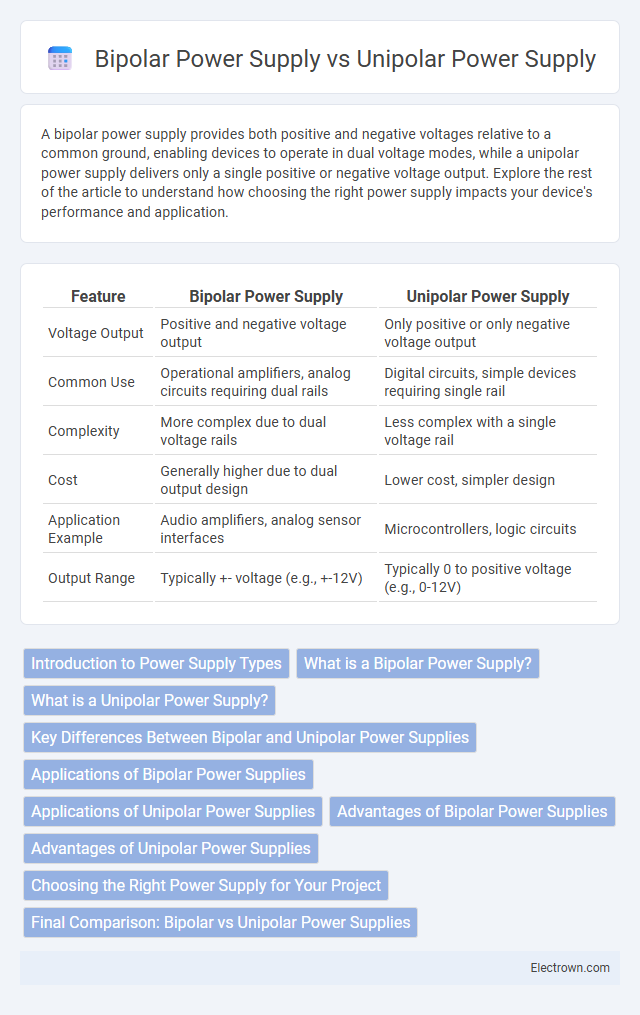A bipolar power supply provides both positive and negative voltages relative to a common ground, enabling devices to operate in dual voltage modes, while a unipolar power supply delivers only a single positive or negative voltage output. Explore the rest of the article to understand how choosing the right power supply impacts your device's performance and application.
Table of Comparison
| Feature | Bipolar Power Supply | Unipolar Power Supply |
|---|---|---|
| Voltage Output | Positive and negative voltage output | Only positive or only negative voltage output |
| Common Use | Operational amplifiers, analog circuits requiring dual rails | Digital circuits, simple devices requiring single rail |
| Complexity | More complex due to dual voltage rails | Less complex with a single voltage rail |
| Cost | Generally higher due to dual output design | Lower cost, simpler design |
| Application Example | Audio amplifiers, analog sensor interfaces | Microcontrollers, logic circuits |
| Output Range | Typically +- voltage (e.g., +-12V) | Typically 0 to positive voltage (e.g., 0-12V) |
Introduction to Power Supply Types
Bipolar power supplies deliver both positive and negative voltages relative to a common ground, enabling applications requiring symmetrical voltage swings such as operational amplifiers and analog circuits. Unipolar power supplies provide voltage strictly above ground, commonly used in digital circuits and systems needing a single polarity power source. Understanding these distinct types is essential for selecting the appropriate power supply based on voltage requirements and circuit design.
What is a Bipolar Power Supply?
A bipolar power supply provides both positive and negative voltage outputs relative to a common ground, enabling circuits to operate with dual polarities. This type of power supply is essential for applications requiring symmetrical voltage swings, such as operational amplifiers, analog signal processing, and certain communication devices. Understanding the functionality of a bipolar power supply helps you choose the right power source for precision electronics and complex signal modulation tasks.
What is a Unipolar Power Supply?
A unipolar power supply delivers voltage or current in a single polarity, either positive or negative, relative to a common ground, making it ideal for devices that require a stable linear input without reversing polarity. Unlike bipolar power supplies that provide both positive and negative outputs, unipolar supplies simplify circuit design and reduce complexity in applications like digital logic circuits or certain sensors. Understanding the nature of your unipolar power supply ensures efficient power delivery tailored to circuits that do not need bidirectional voltage swings.
Key Differences Between Bipolar and Unipolar Power Supplies
Bipolar power supplies provide both positive and negative output voltages relative to a common ground, enabling operation in applications requiring symmetrical voltage swings such as analog circuits and audio amplifiers. Unipolar power supplies offer only a single polarity output voltage, typically positive, making them ideal for powering digital circuits and devices that do not require negative voltages. Your choice between bipolar and unipolar power supplies depends on the specific voltage requirements and the nature of the load in your electronic design.
Applications of Bipolar Power Supplies
Bipolar power supplies are essential in applications requiring both positive and negative voltage outputs, such as analog signal processing, electrochemical experiments, and telecommunications equipment. These power supplies enable precise control of voltage polarity, crucial for driving operational amplifiers and powering circuits with symmetric voltage rails. Their versatility makes them ideal for laboratory testing, medical devices, and audio equipment, where dual polarity is vital for accurate performance.
Applications of Unipolar Power Supplies
Unipolar power supplies are commonly used in applications requiring a single polarity voltage output such as digital circuits, microcontrollers, and logic devices where a consistent positive or negative voltage is needed. These power supplies are ideal for powering sensors, amplifiers, and LED drivers that operate within a unidirectional voltage range. Your choice of a unipolar power supply optimizes system efficiency in devices where bipolar voltage swings are unnecessary.
Advantages of Bipolar Power Supplies
Bipolar power supplies provide both positive and negative voltage outputs, enabling versatile applications in analog signal processing and operational amplifier circuits. They offer improved efficiency and signal symmetry, reducing distortion and enhancing overall performance in audio and instrumentation systems. The capability to handle dual polarities simplifies circuit design and supports a wider range of electronic components compared to unipolar power supplies.
Advantages of Unipolar Power Supplies
Unipolar power supplies provide a stable and noise-free voltage output, making them ideal for applications requiring precise voltage control, such as analog circuits and sensor systems. They are generally simpler in design and cost-effective compared to bipolar power supplies, reducing complexity and maintenance needs. Your electronic projects benefit from their efficiency and ease of use when a single polarity voltage is sufficient.
Choosing the Right Power Supply for Your Project
Selecting between bipolar and unipolar power supplies depends on your project's voltage and current requirements, as bipolar supplies provide both positive and negative voltages suitable for analog circuit testing and operational amplifiers. Unipolar power supplies deliver a single polarity voltage, making them ideal for digital circuits and basic powering needs where negative voltages are unnecessary. Understanding your circuit's voltage polarity needs ensures you choose the right power supply to optimize performance and prevent damage.
Final Comparison: Bipolar vs Unipolar Power Supplies
Bipolar power supplies deliver both positive and negative voltages, making them ideal for applications requiring symmetric power rails, such as operational amplifiers and analog circuits. Unipolar power supplies provide a single polarity output, typically simpler and more cost-effective, suited for digital circuits and devices operating on a single voltage range. Your choice between bipolar and unipolar power supplies depends on the specific voltage requirements and complexity of your electronic system.
Bipolar Power Supply vs Unipolar Power Supply Infographic

 electrown.com
electrown.com